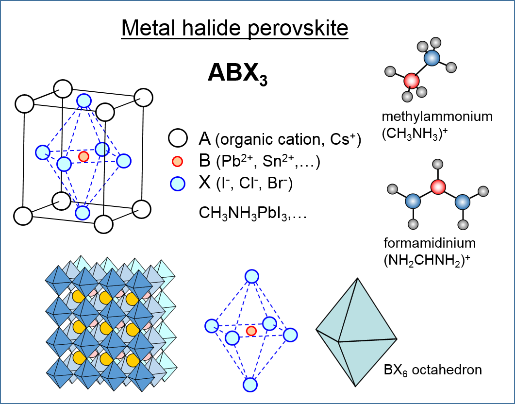Institute Silicon Photovoltaics
Metal halide perovskites for solar cells
The activities of our institute are aimed to the development of stable and efficient c-Si / perovskite tandem solar cells. In this context, research topics are directed to the
- A) Engineering of metal halide perovskite materials and interfaces
- B) Degradation mechanisms and defect formation of metal halide perovskites
- C) Charge separation in the bulk and at interfaces with metal halide perovskites
Hybrid organic-inorganic metal halide perovskites (metal halide perovskites) represent a class of materials with the stoichiometry ABX3, whereas A, B and X denote an organic cation with the charge +1, for example, CH3NH3+ (methyl amine), an inorganic cation with the charge +2, for example, Pb2+, and an halide ion with the charge -1, i.e. I-, Br- or Cl-, respectively. Metal halide perovskites are semiconductors the band gap of which can be tuned in a wide range by varying the stoichiometry. The valence and conduction bands of metal halide perovskites are formed by states in the BX6 octahedra which share the X- - corners with neighbored octahedra in perovskite crystals. The structure of the perovskite crystal and the charge are balanced by the organic cations.
Efficiencies of solar cells based on metal halide perovskites exceed 20%. The tunability of the band gap and the fact that metal halide perovskites can be prepared from salt solutions at low temperatures make solar cells based on metal halide perovskite very attractive for top device in tandem solar cells with c-Si bottom cells. It is expected that the efficiency of photovoltaic modules will be strongly increased with c-Si / perovskite tandem solar cells. For this purpose, the long-term stability of the material, the charge separation at the interfaces and the efficiencies of solar cells based on metal halide perovskites have to be enhanced and investigated in detail. A deeper understanding of properties and processes of defect formation in metal halide perovskites is required in order to design metal halide perovskites with high stability and high energy conversion efficiencies.
Our institute provides a broad technology platform for the preparation of solar cells based on metal halide perovskites. This platform (HySprint and other labs) includes the solution and evaporation based deposition of metal halide perovskites and a large number of organic and inorganic layers and layer systems for charge-selective and ohmic contacts. Analytical methods can be applied for the characterization of solar cells, of the structure, chemical bonds, optical and photo-electric properties of metal halide perovskites and of interfaces with metal halide perovskites. Dedicated investigations can be performed, for example, by using photoluminescence, Raman-, infrared- and ellipsometric spectroscopies, effusion and transient methods of surface photovoltage.
See also the young investor groups working on perovskites:

